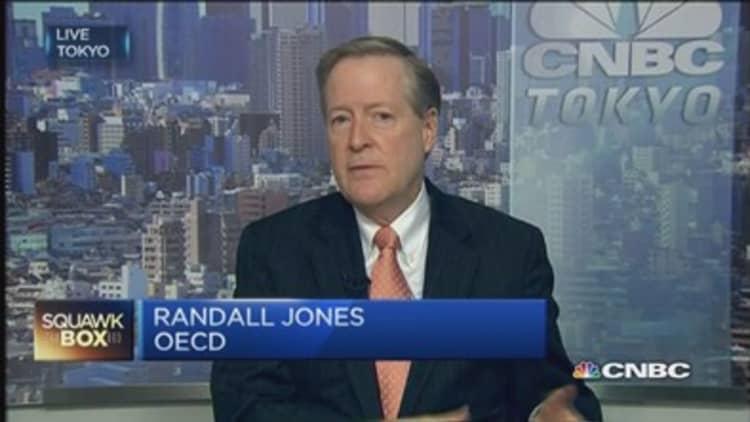
Japan must keep an eye on how much its massive bond-buying program is disrupting the bond market, but it is right to tackle perpetual crippling deflation, says the Organization of Economic Co-operation and Development's top regional economist.
"QQE (qualitative and quantitative easing) has been very successful at raising inflation expectations to around two percent…and we have to trade off the risk of qualitative and quantitative easing with allowing deflation to continue," Randall Jones , the OECD's Head of Japan & Korea Desk, told CNBC.
After two years of a 80 trillion yen ($671 billion) monetary easing program, the Bank of Japan's 2 percent inflation target has proven to be elusive. If anything, the country is again flirting with deflation. In February, core consumer prices were flat year-on-year and many economists are forecasting low oil prices will tip Japan's inflation rate into the negative over the next months.
However, Japanese consumers certainly feel like prices will rise: on average, they believe prices will rise by 4.8 percent over the next year, according to the most recent BOJ survey of consumers published on April 2.
In the works
The OECD does acknowledge in its report published on Wednesday that the BOJ's asset purchases -- which are designed to free up banks to help kickstart the economy by getting people spending more and push up prices -- carry some risks. The main hazard is that the sheer size of the QE program could disrupt the bond market. In Tokyo, many are worried that has already happened.
With the BOJ sweeping up all the Japanese government bonds (JGBs), liquidity has dried up which in turn has led to sharply swings in prices, analysts say.
"It's calmed down a little for now, but rates have tumbled and liquidity has dried up because the BOJ is buying up all the JGBs," Mizuho Securities senior rates strategist Noriatsu Tanji told CNBC by phone.
The yield on 10-year JGBS has fallen from just above 1 percent before the BOJ launched its first round of monetary easing in late April 2012, to a record low of 0.207 percent on January 19 2015, two months after the second round of easing was launched on October 31. The yield on the 10-year JGBs was quoted at 0.326 percent at mid-day Asia time on Thursday.
Watch out for 2016
The main reason for the BOJ's increased appetite for JGBs is the momentous shift in public pension funds' asset allocation strategies, said Tanji.
The Government Pension Investment Fund of Japan, the world's largest public pension fund with assets of 137 trillion yen ($1.15 trillion), is in the midst of reducing its JGB holdings from 60 percent to 35 percent of its portfolio in a bid to improve returns. Many state-related pension funds are following suit, creating a flood of JGBs for sale.
The biggest risk for the BOJ's QE program may be lurking when that supply dries up, however.
If no one offers to sell JGBs to the BOJ, QE will cease to function, Tanji warns.
"For now, the GPIF and other pension funds will sell to the BOJ. But who knows what will happen after that," he said.

